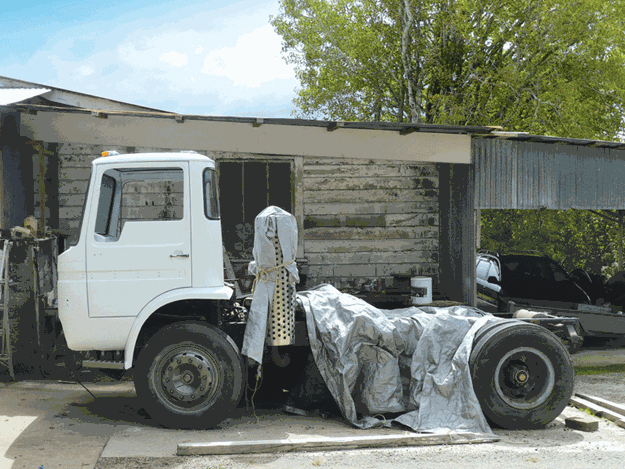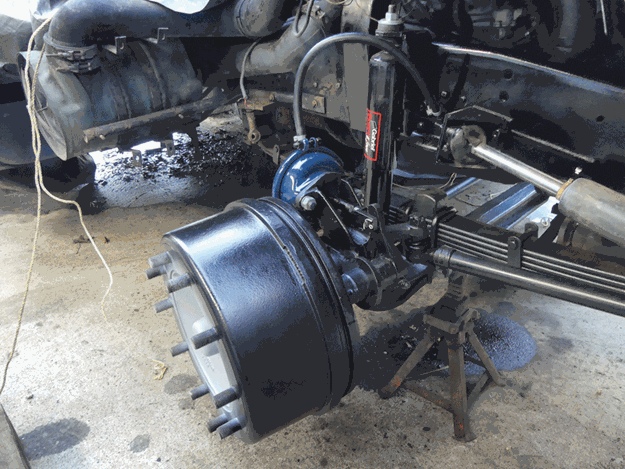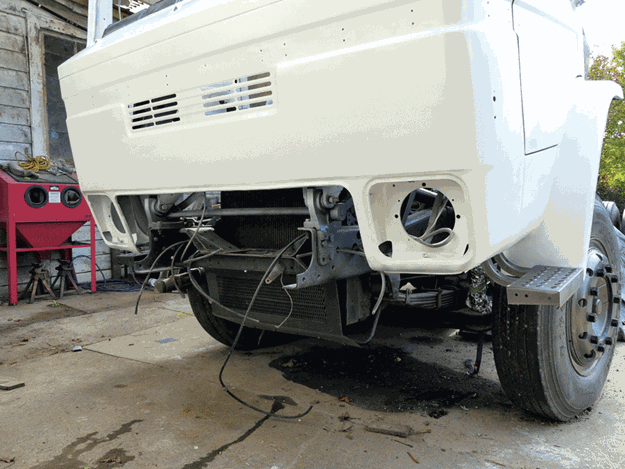Restoration: Dodge — Part 15
A combination of seemingly incessant rain, a truck being worked on outside, and my mechanical ineptitude have consistently threatened to put the kybosh on this current restoration
 |
|
The last time you’ll see it sitting here — promise!
|
I may have had a modicum of success in restoring the likes of my K Bedford and the FGK Morris tow wagon, a fire engine, as well as a couple of cars over the past eight or nine years but this time round, it looks like I’ve bitten off more than I can chew.
Weather-related issues
 |
|
This cab sourced by Noel Galloway provided many useful bits
|
While the South Island has reportedly been bathed in the most sunshine hours in recorded history, Auckland on the other hand has had a dowsing of biblical proportions, even in what was supposed to be our summer.
For a time, I had covers over the truck when it wasn’t being worked on, however, this method of affording some protection turned out to be almost worse than no covers at all.
I kept hoping against hope that the weather would take a turn for the better, however, this pipedream has been put to bed with the rapid onset of winter and still not a lot of fine weather in sight.
The upshot of all of this is that although I managed to get what I thought was a decent coat of paint on the cab during a hiatus in the rain pattern some weeks
(or was it some months) ago because the truck has sat outside for so long, rust spots are beginning to show through at some of the seams.
I hear some of the readers asking why I haven’t shifted the truck to a covered location? A perfectly reasonable question, however, an inability to get it moving has stopped that as well. I’ll explain in more detail in a moment.
Mechanical ineptitude
 |
|
Front brakes sorted, working on the back ones next
|
As said earlier, even I must admit that I didn’t fair too badly with the restorations of my smaller vehicles despite little previous experience in the field of saving old trucks and giving them a new lease on life.
It appears that by getting a few runs on the board earlier in the piece, I started getting ideas above my station when deciding to take on the Dodge as a project.
I now realise that trucks in the 1.5- to three-tonne carrying capacity are probably the height of my limited ability, and they probably should be no later than early 1960s models, just to play it safe.
 |
|
The marker lights were the first sign of completion
|
Hark back a couple of months and I was thinking that getting the rig into a moveable state only involved firing the engine up after a year-long stay of inactivity, getting the clutch to operate and reinstating the air brakes.
Now, I’ve carried out most of these procedures on many occasions in the past, so what could possibly go wrong I asked myself. We were off to a flying start with the engine firing up on the first compression and to add to the success, we had good oil pressure and cooling.
Back then it seemed like the restoration process wouldn’t take too long, and with only the clutch and brakes to go, it should have been straightforward.
Clutching’ at straws
Just a week or two before I had a similar problem to deal with on the 1964 FGK Morris, whereby its clutch slave cylinder had seized due to a lack of use. The fix was quite simple, only taking an hour and a half at the most to rectify the problem, including bleeding the system.
Given in Morris’ case, the pressure due to the height between the reservoir and slave cylinder was around 300mm, the Dodge job should’ve had less potential for failure because of a head of close to a metre between the reservoir and the slave cylinder.
This turned out to not be the case. Perhaps I should explain that the Dodge is fitted with an air-assisted clutch, which is something I’ve never encountered before.
Nevertheless, that shouldn’t have contributed to the fact that no matter what a few of my mates and I did, the result was always the same — no resistance at the clutch pedal.
I must’ve had that confounded master cylinder in and out of the truck close half a dozen times. Anyway, back on the shop floor, I removed the cylinder once again and took it to the guys at Sterling Clutch and Brake in Onehunga, who gave the unit a ‘birthday’ and assured me it was working to spec.
I put it back in the truck once again and even pressure-bled the line until I was sure there definitely wasn’t any air in the line, but still, the pedal was offering zero resistance.
Proving that what I lack in smarts is made up with tenacity, I removed the cylinder one more time and on my mate Murray’s suggestion, made what turned out to be a kind of Heath-Robinson (complicated in design but having a simple function — Ed) test rig where Murray and I set about filling the unit with fluid and bleeding it into a jar.
This proved beyond a doubt that the master cylinder was doing what it was supposed to do, so it was back to fitting it on the truck for one last time.
A smidgen of success
 |
|
Lots more to do here before completion day
|
After about half an hour of faffing about, I finally had a smidgen of pressure at the pedal. It wasn’t much but enough to be able to reverse bleed the system with an oilcan full of fluid.
Another few pumps on the pedal and eureka! we finally had a solid pedal. With part one of a three-part process out of the way, it was time to pay attention to the air assistance side of the clutch equation.
At the end of a long day in the workshop, we were in the final stages of a process where the clutch was hydraulically operational. It may have taken about 20 times as long as it should have, but finally, we were moving forward albeit, oh so slowly.
Being mindful of the fact that 15 months have so far gone into this operation, a process that should have taken 18 to 20 months from start to finish, I was hoping to be able to fulfil my hope of having the truck moved undercover and being able to take some photos to prove that I’ve managed to do that.
At this point in time, we have solid hydraulics to the clutch but still no air assistance, but with the Ed reminding me that the deadline had arrived, the next part of the saga will come to light in Part 16.
Find new and used heavy machinery for sale in NZ
Keep up to date in the industry by signing up to Deals on Wheels' free newsletter or liking us on Facebook.






.jpg)

.jpg)


.gif)
.gif)
.gif)
.gif)
.gif)
.jpg)
